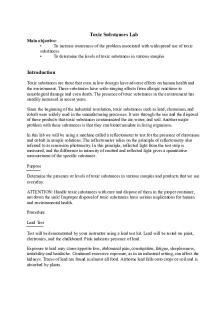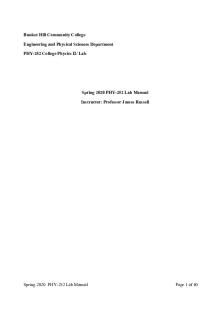Toxic lab manual PDF

| Title | Toxic lab manual |
|---|---|
| Author | Jordan Nelson |
| Course | Introduction to Environmental Science Lab |
| Institution | Florida International University |
| Pages | 4 |
| File Size | 94.7 KB |
| File Type | |
| Total Downloads | 11 |
| Total Views | 153 |
Summary
Lab report is mandatory to receive a good grade in the class. ...
Description
Toxic Substances Lab Main objective: • To increase awareness of the problem associated with widespread use of toxic substances • To determine the levels of toxic substances in various samples
Introduction Toxic substances are those that even in low dosages have adverse effects on human health and the environment. These substances have wide-ranging effects from allergic reactions to neurological damage and even death. The presence of toxic substances in the environment has steadily increased in recent years. Since the beginning of the industrial revolution, toxic substances such as lead, chromium, and cobalt were widely used in the manufacturing processes. It was through the use and the disposal of these products that toxic substances contaminated the air, water, and soil. Another major problem with these substances is that they can bioaccumulate in living organisms. In this lab we will be using a machine called a reflectometer to test for the presence of chromium and cobalt in sample solutions. The reflectometer relies on the principle of reflectometry also referred to as remission photometry. In this principle, reflected light from the test strip is measured, and the difference in intensity of emitted and reflected light gives a quantitative measurement of the specific substance. Purpose Determine the presence or levels of toxic substances in various samples and products that we use everyday. ATTENTION: Handle toxic substances with care and dispose of them in the proper container, not down the sink! Improper disposal of toxic substances have serious implications for human and environmental health. Procedure Lead Test Test will be demonstrated by your instructor using a lead test kit. Lead will be tested on paint, electronics, and the chalkboard. Pink indicates presence of lead. Exposure to lead may cause appetite loss, abdominal pain, constipation, fatigue, sleeplessness, irritability and headache. Continued excessive exposure, as in an industrial setting, can affect the kidneys. Traces of lead are found in almost all food. Airborne lead falls onto crops or soil and is absorbed by plants.
Chromate Test 1. Turn on the reflectometer by pressing the ON/OFF button. 2. Press TEST button until the pointer is pointing to number 2. The display screen should display number 616. 3. Use the colorimeter tubes. Pour 5 mls of each of the five substances into the tubes. 4. Add 5 drops of Chromate and swirl. 5. Remove 1 analytical test strip and immediately close the tube. 6. Press the START button on the reflectometer. The test specific reaction time is shown for 30 seconds. You will have approximately 30 seconds to immerse the test strip into the colorimeter tube for 2 seconds, and shake off excess liquid from the test strip. 7. As soon as the beeper sounds you will have 5 seconds to insert the test strip all the way into the strip adapter with the reaction tab facing the display. 8. Read the results from the display and multiply that number by .488 to get the mg/l for Chromate. 9. Record color change on the reaction tab. 10. Repeat this procedure for the remaining 4 substances. Chromium (111) occurs naturally in fruits, vegetables and grains and is essential to human health; shortages may result in heart conditions, disruption of the metabolic rate as well as diabetes. Contaminated well water may contain the dangerous chromium (IV); hexavalent chromium. Various ways of food preparation and storage may alter the chromium contents of food. When food is stores in steel tanks or cans chromium concentrations may raise. The recommended daily intake of Chromium is 120 µg, doses over 200 µg may result in fainting. Cobalt 1. Switch on the reflectometer by pressing the ON/OFF button. 2. Press the TEST button until the pointer is pointing to the number 3. The display screen should display the number 411. 3. Use the colorimeter tubes. Pour 5 mls of each of the five substances into the tubes. 4. Remove 1 analytical test strip from the tube and immediately close. 5. Press the START button on the reflectometer. The test specific reaction time is shown for 15 seconds. You will have approximately 15 seconds to immerse the test strip into the colorimeter tube for 2 seconds, and shake off excess liquid from the test strip. 6. As soon as the beeper sounds you will have 5 seconds to insert the strip all the way into the strip adapter with the reaction tab facing the display.
7. Read the results from the display and record the displayed number to get the mg/l for Cobalt. 8. Record color change on the reaction tab. 9. Repeat this procedure for the remaining 4 substances.
Cobalt is used in the preparation of paints, ink, varnishes and in radiotherapy. Cobalt poisoning has been linked to dilated cardiomyopathy. Conclusion Write a paragraph on the toxic substances. Which products contain lead? Explain how chemical substances react in the environment and what effects they have on living organisms, such as bioaccumulation or biomagnifications. What happens to humans when exposed to toxic substances? Explain the difference between a mutagen, teratogen, and carcinogen. Finally, what are some ways we can dispose of chemical substances to ensure they will not harm living organisms or humans? What kinds of regulations can we impose to restrict their use? The following link will be helpful in writing your response. http://www.scorecard.org/...
Similar Free PDFs

Toxic lab manual
- 4 Pages

Toxic Plants Assignment
- 13 Pages

DAY-13 Toxic Relationship
- 11 Pages

Toxic - musica ukulele
- 3 Pages

CN-Lab-Manual - Full Lab Manual
- 34 Pages

Lab manual
- 49 Pages

Lab Manual
- 60 Pages

IMH-LAB- Manual manual manual
- 21 Pages

The Toxic Triangle - Grade: 95
- 4 Pages

ECE235 Lab Manual lab work
- 53 Pages

DLD LAB 1 - Lab manual
- 7 Pages

LAB Fisica 4 - Manual lab
- 58 Pages

DBMS Lab Manual - DBMS Lab
- 42 Pages

Physics-LAB - Physics lab manual
- 54 Pages

Data Analgesic Lab Manual
- 22 Pages

Lab Manual Machine Learning
- 27 Pages
Popular Institutions
- Tinajero National High School - Annex
- Politeknik Caltex Riau
- Yokohama City University
- SGT University
- University of Al-Qadisiyah
- Divine Word College of Vigan
- Techniek College Rotterdam
- Universidade de Santiago
- Universiti Teknologi MARA Cawangan Johor Kampus Pasir Gudang
- Poltekkes Kemenkes Yogyakarta
- Baguio City National High School
- Colegio san marcos
- preparatoria uno
- Centro de Bachillerato Tecnológico Industrial y de Servicios No. 107
- Dalian Maritime University
- Quang Trung Secondary School
- Colegio Tecnológico en Informática
- Corporación Regional de Educación Superior
- Grupo CEDVA
- Dar Al Uloom University
- Centro de Estudios Preuniversitarios de la Universidad Nacional de Ingeniería
- 上智大学
- Aakash International School, Nuna Majara
- San Felipe Neri Catholic School
- Kang Chiao International School - New Taipei City
- Misamis Occidental National High School
- Institución Educativa Escuela Normal Juan Ladrilleros
- Kolehiyo ng Pantukan
- Batanes State College
- Instituto Continental
- Sekolah Menengah Kejuruan Kesehatan Kaltara (Tarakan)
- Colegio de La Inmaculada Concepcion - Cebu